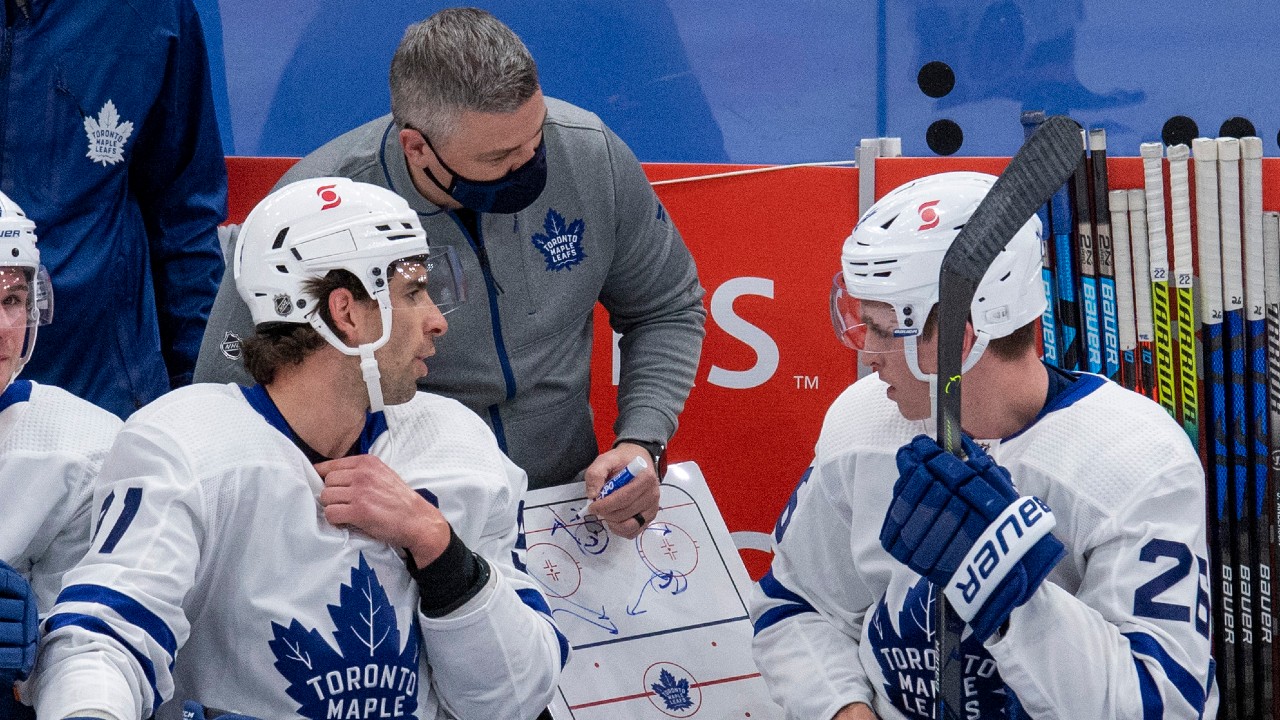TORONTO — As the dust settles on what Auston Matthews termed “a shotgun start” to the Toronto Maple Leafs’ 2021 campaign — the club ran through 10 games in 18 days, losing two skilled forwards and two backup goalies in the process — there are plenty of positives to celebrate from this 7-2-1 burst.
Toronto’s 15 points and six regulation wins have vaulted it to a share of the league lead.
Previously prone to blowouts either way, these Maple Leafs are thriving in tight conditions, going 5-0-1 in one-goal contests.
The Leafs’ vaunted No. 1 power-play has ascended to deadly new heights (43.3 per cent) under new assistant coach Manny Malhotra’s two-unit attack that makes smart use of Wayne Simmonds and Zach Hyman’s net-front ferocity.
Their best players are their best players. Each of Mitch Marner, John Tavares and Matthews has produced a point per game or better; William Nylander (nine points) and Morgan Rielly (seven) aren’t far behind.
Toronto’s faceoff prowess is top five again (53.3 per cent), and its depth has been flexed early. Fourteen different Leafs have scored a goal. Twenty have registered a point.
Yet despite these feel-good signs, staff and players have been quick to note the need for improvement. There is a pervasive sense that the roster still isn’t clicking the way it should be.
“The greatest news of all is that none of the games have been perfect and there’s lots of room for growth still,” head coach Sheldon Keefe says. “I wouldn’t say there’s been really any pleasant surprises. I think we’ve met expectations in a lot of ways, and there still remains many areas for us to get better.
“That’s exciting for us as a team.”
[snippet id=5040828]
Enough with the back-slapping. Let’s dig into five areas for improvement.
Grabbing leads is great, expanding leads is better
Toronto has appeared to have remedied its “start on time” issue that plagued recent regular seasons, as the Leafs have outscored their opposition 9-7 in the first period. But that margin shrinks as the games wind on.
They often grab a lead but have yet to run away laughing with a single one.
“We’d like to have a little more comfortable lead heading into the third period — or at least have it not be such a nailbiter,” said defenceman Justin Holl, flashing a smile. “I would like that, at least.”
The back-and-forth tug-o-wars are fantastic for entertainment and for getting players comfortable with duress. But this avalanche of tight third periods has forced Keefe to shorten his bench and throw a ton of minutes on the plates of Matthews and Marner. Both rank top-five leaguewide in time-on-ice for forwards.
A trickle-down effect spells fewer shifts for an in-flux bottom six that Keefe is still trying to evaluate and discover the best chemistry.
“One of the big things would be for us just to get really comfortable in playing with leads and having a good process in place that can allow us to take care of that lead but push more on the offensive side of it,” Keefe said. “When I say that, that’s doing it responsibly.”
[radioclip id=5055406]
Dominating at even-strength
The Maple Leafs’ 5-on-4 prowess, improved defensive play and fine shooting percentage (11 per cent, when the league average is 9.9) have done an excellent job masking the fact that they’ve only been a middle-of-the-pack outfit when it comes to offence 5-on-5.
Known for their firepower, the Maple Leafs rank just 18th overall in shots per game (29.9), and most of their possession metrics (50.4 CF%) have dipped from last year’s pace. A coach who has always prided his rosters on owning the puck notices these things.
Chalk it up to a three-ingredient cocktail of line juggling, a stronger defensive mandate and the absence of a pre-season to integrate all those fresh faces. But the fact remains: High-powered Toronto has slipped out of the top-10 in goals per game (3.3).
And its ratio of even-strength goals (20, including two empty-netters) to power-play goals (13) feels something less than optimal.
During rare back-to-back full-team practices Tuesday and Wednesday, Keefe will stress the importance of increasing his group’s offensive zone time.
“We need to find ways to control play a little bit better and generate more shots, more opportunities offensively,” Keefe said.
[radioclip id=5055403]
Stay out of the freakin’ box
Toronto’s subpar penalty kill has been described as a work in progress.
That progress has yet to be made. The work is plentiful.
The Leafs are on pace to see their kill rate drop for a fourth straight season. It currently sits at 76.9 per cent (21st overall), and Connor McDavid put it on blast during his early Goal of the Year contender Saturday.
“It’s always tough on a goalie when you’re taking as many penalties as we are,” Keefe explained.
The coach has cracked the whip both privately and publicly on his group’s tendency to commit unnecessary stick fouls, which was an issue in the Mike Babcock era too.
Toronto is hardly a rugged group, but it commits 3.28 penalties per game, seventh-worst in the NHL. Toss in the Leafs’ relative inability to draw penalties, and only two clubs have a worse penalty differential (-1.09 per game) than the Leafs.
Imagine how much more damage their power play could inflict if it wasn’t among the bottom third in the league in opportunities.
Diehard fans will be quick to show you gifs of borderline calls that didn’t fall Toronto’s way, and whistles are being blown at an 11-year high. The NHL is now seeing 3.64 power-play opportunities per team per game.
“The standard changes year to year, and it’s just a matter of us adapting,” said Alexander Kerfoot, owning the issue. “The refs are going to call the game however they want, and that’s their job. They have a tough job themselves, and we have to learn from whatever it is they’re going to be calling on a nightly basis and do a better job to not take penalties.”
It’s the little things that matter
Keefe will often emphasize the need to clean up details, and on Monday he put his troops through a skills-development session rife with repetition.
Pick up a hard puck off the wall, then peel away a dozen more.
As successful as the Leafs are at thieving pucks away from their enemy – at 6.75 per game, they rank third overall in takeaways — they might just float it right back.
Toronto commits more giveaways per 60 minutes (10.23) than all 30 other teams.
Other quibbles: Even with blue-collar additions like Simmonds and Zach Bogosian performing as advertised, the Maple Leafs still rank among the league basement dwellers in hockey’s gruntier physical aspects like hits (17.2 per 60) and blocked shots (11.9 per 60).
The Leafs’ team save percentage (.895, 24th overall) looks ugly, but the recent eye test and timely save test on Frederik Andersen suggest this number should only rise. Health willing.
Roster juggling makes for antsy players
“Probably the biggest wrinkle in this whole thing is we’re still unsure about a lot of guys and where they fit in and what they can offer us,” Keefe says. “We’ve got to find our way to give them some opportunities to show what they can do and figure out what our best mix will be. Once we have those answers, I think we’ll find a little more consistency in our lineup.”
So, Travis Boyd can wait two weeks to dress, enjoy a two-game point streak, then get treated to a healthy scratch.
Travis Dermott can be a plus-two, do everything his coaches have asked of him and still sit for seven days.
Adam Brooks can average a goal a game and go right back to taxi duty.
An ill-timed puck-over-glass penalty can stunt Joey Anderson’s tryout.
And Rasmus Sandin, the franchise’s prized defence prospect, can get stuck in eighth-defenceman purgatory until further injury.
“There is some growth to be had there,” Keefe noted Monday of Sandin. “We have no doubt he’s going to be an everyday NHLer.”
If there is a downside to depth and all this bubbling internal competition, it’s that keeping everyone engaged and content is a near-Herculean task.
Ask yourself this: Would giving up on fringe players like Mikko Lehtonen and Alexander Barabanov before they’ve been granted an ample look in North America harm the organization’s chances of luring European free agents in the future?
We think Keefe has done an admirable job incorporating the taxi squad.
He’s trying to balance the need to bank points with the need to figure out his ideal third pairing and develop a third and fourth line he can trust.
“As much as they’re in our practices and they’re around, it’s tough,” Keefe says of all those healthy scratches. “They’re just kind of sitting around and practising.
“We’ll see how injuries go and all those kinds of things, but right now, we’ve got to keep moving things around a little bit.”
Are the Maple Leafs off to a strong start? Absolutely.
Are they immune from improvement or blind to their blemishes? Not at all.
Says Keefe: “We expect to bring it to another level when we come back to play after this break.”
[relatedlinks]






COMMENTS
When submitting content, please abide by our submission guidelines, and avoid posting profanity, personal attacks or harassment. Should you violate our submissions guidelines, we reserve the right to remove your comments and block your account. Sportsnet reserves the right to close a story’s comment section at any time.